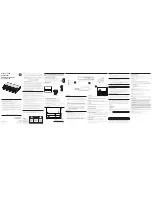
1-2
PA-8T-232 Synchronous Serial Port Adapter Installation and Configuration
OL-3562-03
Chapter 1 Overview
Serial Interface Specifications
Note
Although the Cisco 7304 PCI Port Adapter Carrier Card in the Cisco 7304 router, Catalyst RSM/VIP2,
Catalyst 6000 family FlexWAN module, and VIP support online insertion and removal (OIR), individual
port adapters do not. To replace port adapters, you must first remove the Cisco 7304 PCI Port Adapter
Carrier Card in the Cisco 7304 router, the Catalyst RSM/VIP2, Catalyst 6000 family FlexWAN module,
or VIP from the chassis and then replace port adapters as required.
Cisco 7100 series, Cisco 7200 series, Cisco uBR7200 series routers, Cisco 7301 routers, and
Cisco 7401ASR routers support online insertion and removal of all port adapter types.
The PA-8T-232 supports non return to zero (NRZ) and non return to zero inverted (NRZI) signaling, and
both 16-bit and 32-bit cyclic redundancy checks (CRCs). The default configuration is for NRZ signaling
and 16-bit CRC. You can change the default settings with software commands. (For more information,
see the
“Configuring the EIA/TIA-232 Interfaces” section on page 5-2
There is no default mode or clock rate set on serial ports, although an internal clock signal is present on
all ports for DCE support. The internal clock also allows you to perform local loopback tests without
having to terminate the port or connect a cable. To use the port as a DCE interface, you must set the
clock rate and connect a DCE compact serial cable. To use the port as a DTE interface, you need only
connect a DTE compact serial cable to the port. Because the serial adapter cables determine the mode
and interface type, the PA-8T-232 interface becomes a DTE when you connect a DTE cable to it.
If you connect a DTE cable to a port with a clock rate set, the DTE ignores the clock rate and uses the
external clock signal that is sent from the remote DCE. For a brief description of the clock rate
command, see the
“Configuring Timing (Clock) Signals” section on page 5-10
. For complete command
descriptions and instructions, refer to the publications listed in the
“Related Documentation” section on
Serial Interface Specifications
Serial signals can travel a limited distance at any given bit rate; generally, the slower the bit rate, the
greater the distance. All serial signals are subject to distance limits beyond which a signal degrades
significantly or is completely lost.
lists recommended transmission speeds and distances for
EIA/TIA-232 serial interfaces. The recommended maximum rate for EIA/TIA-232 is 64 kbps.
Table 1-1
Recommended Transmission Speed Versus Distance
EIA/TIA-232 Distances
Rate (bps)
Feet
Meters
2400
200
60
4800
100
30
9600
50
15
19200
25
7.6
38400
12
3.7
56000
8.6
2.6
2048000
–
–
















































